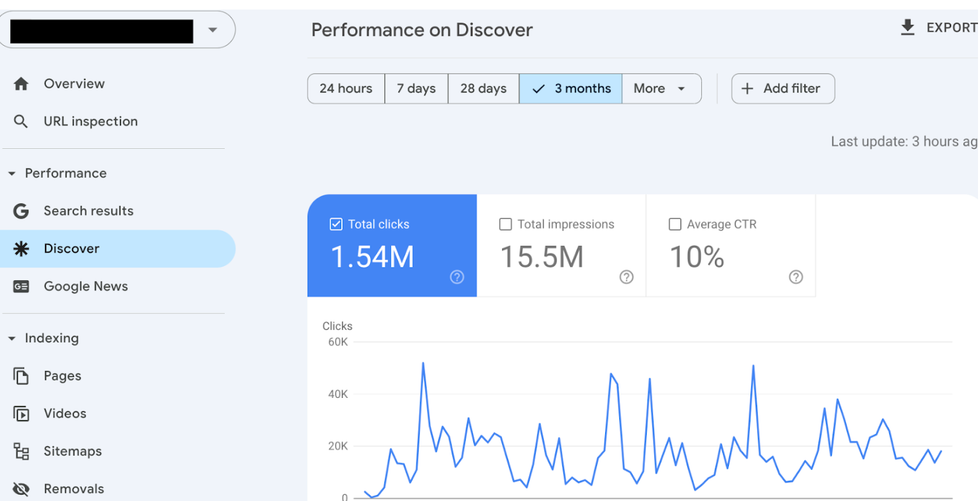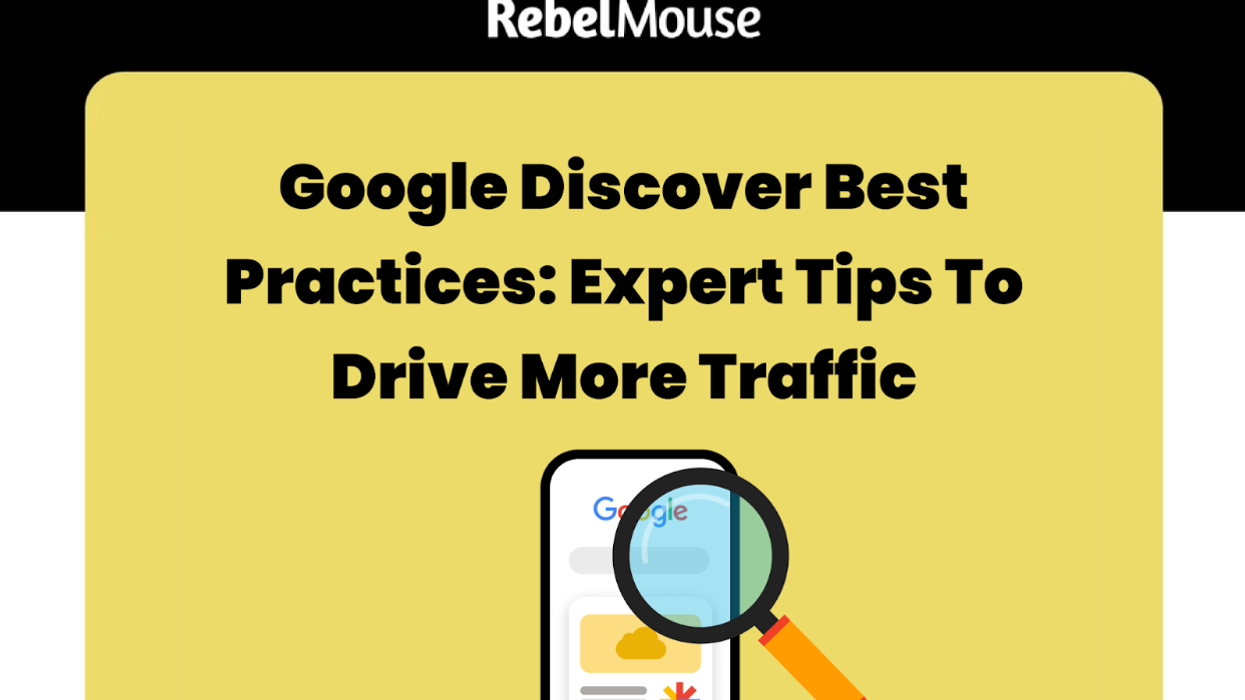Google Discover has the potential to drive a lot of traffic to your website, if it’s not already. For some, it can be an enigma to figure out, but if you fully understand what it is and how it works, you have a shot. That was the theme of a Discover-oriented webinar from WTF is SEO?, led by digital media experts Shelby Blackley of The Athletic and Jessie Willms of The Guardian.
A quick primer: Google Discover is a mobile-only experience of articles recommended for you. It's personalized to every user based on their interests, search history, and other things Google knows about you, such as websites you visit. You’ll see it when you launch www.google.com on a smartphone — the feed of articles below the search functionality — or when you launch the Google Search app.
It took off as a traffic driver in 2024, helping news publishers balance off the decline of social media referrals due to algorithm changes. In fact, Nieman Journalism Lab found that Google Discover started to exceed traffic from Google Search for some publishers. This surge in interest led to a series of explainers, such as this Discover optimization guide from Search Engine Land.
With that background in mind, here are the latest best practices to maximize your reach with Discover and what you can do to drive more traffic:
- Focus on User Experience First
- Prioritize Recency and Updates
- Follow the Content Trends
- Maximize Spikes With Action
- Analyze the Data
We’ll walk you through each of these points, like we did with our Reddit best practices.
Focus on User Experience First
Discover can be highly volatile and unpredictable. This is due to multiple reasons, including the fact that user interest is constantly shifting and Google's core algorithm updates can extend to Discover. This is why it can be challenging to optimize for Discover. Once you think you’ve figured things out, it can change.
Since there's so much that's out of your control, Blackley and Willms advocate that you should focus on organic search first before investing in Discover optimization efforts. One reason that is effective is because when you optimize for traditional SEO, you’re actually focusing on the best user experience possible, as we’ll discuss in our Content SEO webinar.
You want to think about the user journey. Your headline should match the content, and you should deliver on what it promises. The image should be compelling and get your attention. This is especially important for Discover since the headline and image are a couple of the only elements that users see when they make a decision whether or not to click through to your site. If the experience is good, they land on your site, and you cover the topic well, not only are they likely to come back to your site again in the future or explore it further, you’re more likely to have a Discover hit.
Prioritize Recency and Updates
Nothing is more important to Google Discover than content freshness. That’s because it’s meant to be a real-time feed of what’s happening right now, which is kind of Google’s answer to social media — a personalized feed for Google users. So make sure your content strategy emphasizes recency and regularly updating content.
It’s not just about the publish date, either — it goes well beyond that. The content body itself should be making references like “this week,” “last week,” “this month,” and so on. Those phrases should be repeated or at least sprinkled throughout the piece as a key signal that the content is fresh.
Blakeley and Willms emphasized the importance of making actual significant updates to old pieces, not just artificially updating publish dates. You should extend the story and go beyond, do additional research, compile additional insights, and make it worthwhile to surface again. If you do artificially update dates, you’re likely to get caught eventually, and being penalized with less traffic from Discover can be devastating for publishers.
Follow the Content Trends
One of the most interesting things about Discover is that you might have success outside of the type of content that you regularly publish. That’s okay, as you’ve carved out a niche that is appealing to an audience, and you might want to expand on it.
These days, sports, expert opinion, and advice are the key pieces of content that are really taking off on Discover. Think about news that people can use in their everyday life. That can easily extend to categories like finance, health and wellness, and relationships.
One website in particular mentioned during the webinar was a politics site that started to find success with their editorials and commentaries on Discover. They were providing valuable insights and analysis based on their expertise, even though it wasn’t the core of their more news-focused content. So they leaned into that and wrote more expert analysis.
Maximize Spikes With Action
When you are seeing a piece of content take off on Discover, there are actions you can take. For some, if you have access to real-time analytics, it becomes obvious when a story is taking off on Discover. Even if you react the day after, there are some things that you can do.
First, maximize those Discover hits through internal linking. If a piece performs well, obviously it resonated with users, so you should add more internal links to it across your site. For RebelMouse-powered sites, that’s easy to do with SmartLinks.
The same goes for previous Discover hits, even those from a month ago or further back. Regularly link to them in your content, as they are valuable pieces of content. Linking to older, related content that you’ve written about is a great way to build up topical authority.
Finally, the most obvious action item: Create more content like it. If it did well, follow-up posts with updates on the topic or other related content has a better chance to perform well, too. Ask questions like: Is this a part of a broader trend? What else would people be wondering about related to this?
Analyze the Data
It’s incredibly easy to find actionable data for Google Discover in Google Search Console. Simply navigate to the "Discover" tab under the "Performance" section. By default, you should see data from the last three months with a focus on total clicks:

The spikes and drops seen in the chart above are typical for Discover traffic. By nature, the feed is changing quite often for users. If a particular piece of content is doing very well, it may be exposed to more users or stick in feeds a bit longer, leading to those traffic spikes.
One of the main metrics that Google uses to decide how a piece of content is doing is the click-through rate (CTR). You can toggle CTR on to see the click-through rate of various pieces of content. You'll typically see higher CTRs as the result of a well-written headline, while low CTRs can be indicative of a poorly written headline. Use the data to take a look at those headlines, getting actionable insights on how to write better headlines going forward.
One of the most interesting things you can do that is often overlooked is sorting by impressions. Toggle on the "Impressions" tab and sort by most impressions to least. These are pieces of content that Discover found to be a good fit for the audience, even if they didn’t always get the best click-through rates. It might be worthwhile to focus on creating more content like those, but again keep note of the headlines and how they impacted CTR.
While it’s useful to look at data from the last three months, expand to a longer time frame to see the best all-time hits. You’ll also want to look at more recent data — the last seven days is a good start. This will give you insight into valuable trends recently in terms of what is clicking or how your headlines are performing. If you sort by lowest CTRs, it may reveal poorly written headlines.
Based on the data, optimize your headlines moving forward. Keep in mind that og:headline, the "Social Headline" on our platform, is what populates Discover, and you may receive good suggestions for it through AI. Ideally, the headline should utilize curiosity gaps to make readers want to learn more. At the same time, they should not be clickbait-y, and they should deliver on what they’re promising. Blakeley suggested that they should be more “feature-y” than your typical headline — less rigid, and more fun. One more consideration: If a headline is merely telling what the story is, it can be boring — think about your audience and what might get their attention.
The webinar speakers emphasized the importance of exporting the data into a spreadsheet to better understand it. They recommended adding a column like “Content type” so that you can see what types of content you’re producing that resonates most with the audiences across Discover. Be sure to share the most valuable insights with your content team to drive actionable shifts.
Looking for a personalized look at your Discover traffic and ways to optimize or maximize it? Get in touch with one of our strategists today and we’ll be glad to work on recommendations for you.

